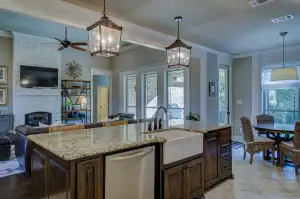Mastering the Art of Cooking: A Beginner's Guide on How to Use a Convection Oven at Home

- Preheat the Oven: Set the convection oven to the recommended temperature for your recipe, typically 25 degrees Fahrenheit lower than a conventional oven.
- Adjust Cooking Time: Reduce the cooking time by about 25% to account for the faster and more even cooking in a convection oven.
- Use the Right Cookware: Opt for shallow pans with low sides to allow for proper air circulation and even cooking.
- Avoid Overcrowding: Leave enough space between dishes to ensure hot air can circulate freely around the food.
- Monitor Food Closely: Keep an eye on your dishes as they cook, as they may finish faster than expected in a convection oven.
- Rotate Dishes: For more even cooking, rotate the position of your dishes halfway through the cooking process.
- Use Lower Temperatures for Baking: When baking, reduce the temperature by 25 degrees Fahrenheit and check for doneness a few minutes earlier than usual.
- Experiment and Adjust: Practice using your convection oven with different recipes to get a feel for how it cooks and make adjustments as needed.
Preheat the Oven: Set the convection oven to the recommended temperature for your recipe, typically 25 degrees Fahrenheit lower than a conventional oven.
Preheating the convection oven is a crucial step in ensuring your dishes cook properly. To start, set the oven to the temperature recommended in your recipe, which is usually 25 degrees Fahrenheit lower than what you would use for a conventional oven. This adjustment accounts for the more efficient heat distribution in a convection oven, resulting in faster and more even cooking. By preheating correctly, you'll set the stage for successful culinary creations every time.
Adjust Cooking Time: Reduce the cooking time by about 25% to account for the faster and more even cooking in a convection oven.
When using a convection oven, it's important to adjust the cooking time to account for its faster and more even cooking capabilities. As a general rule of thumb, you should reduce the cooking time by about 25% compared to what a recipe calls for in a conventional oven. This adjustment helps prevent overcooking and ensures that your dishes come out perfectly cooked every time. Be sure to keep an eye on your food as it cooks, as it may finish sooner than expected in a convection oven. By making this simple adjustment, you can master the art of cooking with your convection oven at home.
Use the Right Cookware: Opt for shallow pans with low sides to allow for proper air circulation and even cooking.
When using a convection oven, it is crucial to select the right cookware to ensure optimal results. Shallow pans with low sides are recommended as they allow hot air to circulate evenly around the food. This promotes consistent cooking and helps prevent any areas from being undercooked or overcooked. The proper air circulation facilitated by this type of cookware also aids in achieving a more uniform browning of dishes, enhancing both appearance and flavor. So, when preparing your meals in a convection oven, opt for shallow pans with low sides to elevate your cooking experience.
Avoid Overcrowding: Leave enough space between dishes to ensure hot air can circulate freely around the food.
To ensure optimal cooking results in a convection oven, it's crucial to avoid overcrowding the oven space. Leaving enough room between dishes allows hot air to circulate freely around the food, promoting even cooking. When items are too close together, airflow is restricted, leading to unevenly cooked dishes. By spacing out your cookware appropriately, you can maximize the efficiency of the convection oven and achieve consistent results with every meal.
Monitor Food Closely: Keep an eye on your dishes as they cook, as they may finish faster than expected in a convection oven.
When using a convection oven, it's crucial to monitor your dishes closely throughout the cooking process. The circulating hot air cooks food faster and more evenly than in a conventional oven, so dishes may finish sooner than expected. To prevent overcooking, check on your food regularly and use a timer to ensure it doesn't stay in the oven longer than necessary. By staying vigilant, you can avoid burnt or dried-out dishes and achieve perfectly cooked meals every time.
Rotate Dishes: For more even cooking, rotate the position of your dishes halfway through the cooking process.
To ensure even cooking in a convection oven, it's important to rotate the position of your dishes halfway through the cooking process. This simple step helps to promote uniform heat distribution and prevent any potential hot spots in the oven. By rotating your dishes, you can ensure that each item receives an equal amount of heat exposure, resulting in more consistent and perfectly cooked meals. Remember to use oven mitts or kitchen towels when handling hot cookware during this process to avoid burns.
Use Lower Temperatures for Baking: When baking, reduce the temperature by 25 degrees Fahrenheit and check for doneness a few minutes earlier than usual.
When using a convection oven for baking, it's essential to adjust the temperature accordingly. Lower the temperature by 25 degrees Fahrenheit compared to what a recipe calls for in a conventional oven. This adjustment helps prevent over-browning or drying out of baked goods. Additionally, since convection ovens cook faster and more evenly, it's advisable to check for doneness a few minutes earlier than you normally would with a traditional oven. By following these steps, you can ensure that your baked goods come out perfectly cooked and delicious every time.
Experiment and Adjust: Practice using your convection oven with different recipes to get a feel for how it cooks and make adjustments as needed.
Experimenting and adjusting is key to mastering the art of cooking with a convection oven. Try out various recipes to understand how your oven cooks differently from a conventional one. Make note of any adjustments needed, such as lowering temperatures or reducing cooking times. By practicing and making tweaks along the way, you'll become more comfortable and confident in using your convection oven effectively. Remember, each recipe may require slight modifications, so don't be afraid to experiment and tailor the settings to suit your preferences.
Published: 11. 04. 2024
Category: Home



